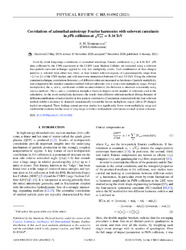Correlations of azimuthal anisotropy Fourier harmonics with subevent cumulants in pPb collisions at √sNN = 8.16 TeV
| dc.contributor.author | Sirunyan, A. M. | |
| dc.contributor.author | Işıldak, Bora | |
| dc.date.accessioned | 2023-05-05T08:05:56Z | |
| dc.date.available | 2023-05-05T08:05:56Z | |
| dc.date.issued | 2021-01-14 | |
| dc.identifier.issn | 2469-9985 | en_US |
| dc.identifier.uri | http://hdl.handle.net/10679/8189 | |
| dc.identifier.uri | https://journals.aps.org/prc/abstract/10.1103/PhysRevC.103.014902 | |
| dc.description.abstract | Event-by-event long-range correlations of azimuthal anisotropy Fourier coefficients ( v n ) in 8.16 TeV p Pb data, collected by the CMS experiment at the CERN Large Hadron Collider, are extracted using a subevent four-particle cumulant technique applied to very low multiplicity events. Each combination of four charged particles is selected from either two, three, or four distinct subevent regions of a pseudorapidity range from − 2.4 to 2.4 of the CMS tracker, and with transverse momentum between 0.3 and 3.0 GeV. Using the subevent cumulant technique, correlations between v n of different orders are measured as functions of particle multiplicity and compared to the standard cumulant method without subevents over a wide event multiplicity range. At high multiplicities, the v 2 and v 3 coefficients exhibit an anticorrelation; this behavior is observed consistently using various methods. The v 2 and v 4 correlation strength is found to depend on the number of subevents used in the calculation. As the event multiplicity decreases, the results from different subevent methods diverge because of different contributions of noncollective or few-particle correlations. Correlations extracted with the four-subevent method exhibit a tendency to diminish monotonically toward the lowest multiplicity region (about 20 charged tracks) investigated. These findings extend previous studies to a significantly lower event multiplicity range and establish the evidence for the onset of long-range collective multiparticle correlations in small system collisions. | en_US |
| dc.description.sponsorship | BMBWF and FWF (Austria); FNRS and FWO (Belgium); CNPq, CAPES, FAPERJ, FAPERGS, and FAPESP (Brazil); MES (Bulgaria); CERN; CAS, MoST, and NSFC (China); COLCIENCIAS (Colombia); MSES and CSF (Croatia); RPF (Cyprus); SENESCYT (Ecuador); MoER, ERC IUT, PUT, and ERDF (Estonia); Academy of Finland, MEC, and HIP (Finland); CEA and CNRS/IN2P3 (France); BMBF, DFG, and HGF (Germany); GSRT (Greece); NKFIA (Hungary); DAE and DST (India); IPM (Iran); SFI (Ireland); INFN (Italy); MSIP and NRF (Republic of Korea); MES (Latvia); LAS (Lithuania); MOE and UM (Malaysia); BUAP, CINVESTAV, CONACYT, LNS, SEP, and UASLP-FAI (Mexico); MOS (Montenegro); MBIE (New Zealand); PAEC (Pakistan); MSHE and NSC (Poland); FCT (Portugal); JINR (Dubna); MON, RosAtom, RAS, RFBR, and NRC KI (Russia); MESTD (Serbia); SEIDI, CPAN, PCTI, and FEDER (Spain); MOSTR (Sri Lanka); Swiss Funding Agencies (Switzerland); MST (Taipei); ThEPCenter, IPST, STAR, and NSTDA (Thailand); TUBITAK and TAEK (Turkey); NASU and SFFR (Ukraine); STFC (United Kingdom); DOE and NSF (USA). Individuals have received support from the Marie Curie programme and the European Research Council and Horizon 2020 Grant, Contracts No. 675440 and No. 765710 (European Union); the Leventis Foundation; the A. P. Sloan Foundation; the Alexander von Humboldt Foundation; the Belgian Federal Science Policy Office; the Fonds pour la Formation a la Recherche dans l'Industrie et dans l'Agriculture (FRIA-Belgium); the Agentschap voor Innovatie door Wetenschap en Technologie (IWT-Belgium); the F. R. S.-FNRS and FWO (Belgium) under the "Excellence of Science -EOS" -be.h Project No. 30820817; the Beijing Municipal Science & Technology Commission, No. Z181100004218003; the Ministry of Education, Youth and Sports (MEYS) of the Czech Republic; the Lendulet ("Momentum") Programme and the Janos Bolyai Research Scholarship of the Hungarian Academy of Sciences, the New National Excellence Program UNKP, the NKFIA research Grants No. 123842, No. 123959, No. 124845, No. 124850, No. 125105, No. 128713, No. 128786, and No. 129058 (Hungary); the Council of Science and Industrial Research, India; the HOMING PLUS programme of the Foundation for Polish Science, cofinanced from European Union, Regional Development Fund, the Mobility Plus programme of the Ministry of Science and Higher Education, the National Science Center (Poland), Contracts No. Harmonia 2014/14/M/ST2/00428, No. Opus 2014/13/B/ST2/02543, No. 2014/15/B/ST2/03998, and No. 2015/19/B/ST2/02861, No. Sonata-bis 2012/07/E/ST2/01406; the National Priorities Research Program by Qatar National Research Fund; the Programa Estatal de Fomento de la Investigacion Cientifica y Tecnica de Excelencia Maria de Maeztu, Grant No. MDM-2015-0509 and the Programa Severo Ochoa del Principado de Asturias; the Thalis and Aristeia programmes cofinanced by EU-ESF and the Greek NSRF; the Rachadapisek Sompot Fund for Postdoctoral Fellowship, Chulalongkorn University and the Chulalongkorn Academic into Its 2nd Century Project Advancement Project (Thailand); the Welch Foundation, contract C-1845; and the Weston Havens Foundation (USA). | |
| dc.language.iso | eng | en_US |
| dc.publisher | American Physical Society | en_US |
| dc.relation.ispartof | Physical Review C | |
| dc.rights | openAccess | |
| dc.rights.uri | https://creativecommons.org/licenses/by/4.0/ | |
| dc.title | Correlations of azimuthal anisotropy Fourier harmonics with subevent cumulants in pPb collisions at √sNN = 8.16 TeV | en_US |
| dc.type | Article | en_US |
| dc.description.version | Publisher version | en_US |
| dc.peerreviewed | yes | en_US |
| dc.publicationstatus | Published | en_US |
| dc.contributor.department | Özyeğin University | |
| dc.contributor.authorID | (ORCID 0000-0002-0283-5234 & YÖK ID 124605) Işıldak, Bora | |
| dc.contributor.ozuauthor | Işıldak, Bora | |
| dc.creator | The CMS Collaboration | |
| dc.identifier.volume | 103 | en_US |
| dc.identifier.issue | 1 | en_US |
| dc.identifier.wos | WOS:000607510800002 | |
| dc.identifier.doi | 10.1103/PhysRevC.103.014902 | en_US |
| dc.relation.publicationcategory | Article - International Refereed Journal - Institutional Academic Staff |
Files in this item
This item appears in the following Collection(s)
Share this page




